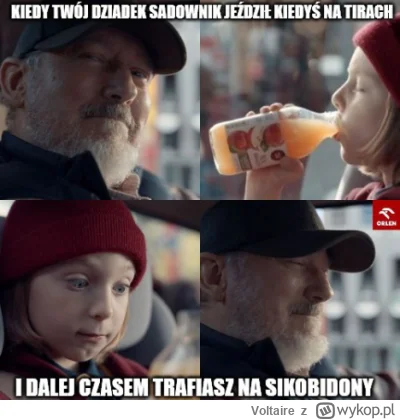#cydr #cydrdomowy
Wszystko
Najnowsze
Archiwum
- 0
Dziś będę robił cydr. Mam sokowirówke, jabłka i wiaderko fermentacyjne. Oraz oczywiście internet.
#cydr #cydrdomowy
#cydr #cydrdomowy
Treść przeznaczona dla osób powyżej 18 roku życia...
@bathor_dyktator: wszędzie kupisz, nawet w Żabkach jest. I tanie fabryczne są całkiem pijalne, nie ma co szukać na siłę niewiadomo czego.
@bathor_dyktator: W auchan jest spory wybór tylko nie wiem czy akurat takie jest "spoko" xd mają cała ofertę takiej cydrowej podstawki: lubelski, sadowski, dobroński, notecki, hoggys no i miłosławski - ogólnie są w różnych smakach, od klasyków, przez perry, a na arbuzowych kończąc.
W aldi wleciały teraz francuskie pur pom, piłem, spoko.
A najlepsze cydry piłem z Chyliczek, ale w markecie nie dostaniesz raczej.
Właśnie jestem na etapie nadrabiania cydrów,
W aldi wleciały teraz francuskie pur pom, piłem, spoko.
A najlepsze cydry piłem z Chyliczek, ale w markecie nie dostaniesz raczej.
Właśnie jestem na etapie nadrabiania cydrów,
Wybrałem się na spacer po Czeskim Cieszynie, oglądałem sklepiki u Azjatów i postanowiłem wracać, wróciłem przez park Sikory nagle wyrosło dwóch z służby celnej podjechali radiowozem, zrobili mi kontrolę plecaka, kieszeń i portfela sprawdzili dowód, potem skierowali ręką dalej, kazali stanąć zaprowadzili mnie pod pakę gdzie mieli psa on mnie od góry do stóp wąchał cały czas, mówi o Marysi ja zaprzeczałem bo lubię Cydr a tu jest tani Cydr taka przygoda
- 2
Jak zbiorę resztę to jeszcze ze 3x tyle będę miał. W zeszłym roku nie zebrałem i mi się zmarnowało, w tym zebrałem, ale w sumie nie wiem po co bo żona mówi, żebym nalewek nie robił bo mogą wyjść zbyt dobre ;P
Robił ktoś coś z tym innego poza nalewkami? Może jakiś sok, dżem albo wino lub cydr itp. Im mniej alko tym lepiej. Zarzućcie sprawdzonym. przepisem.
Edit: te polewej to oddzieliłem
Robił ktoś coś z tym innego poza nalewkami? Może jakiś sok, dżem albo wino lub cydr itp. Im mniej alko tym lepiej. Zarzućcie sprawdzonym. przepisem.
Edit: te polewej to oddzieliłem

źródło: pigwowiec
Pobierz@BeginEnd: jak pigwówka z pigwy :) w pigwowcu po prostu jest więcej smaku. Jeśli wogóle nie znasz to kup jakaś małpkę w sklepie a potem pomnóż smak razy nieskończoność i wyjdzie ci mniej więcej jak dobra jest domowa pigwówka.
- 0
@supersucker: no nie znam. Ojciec kiedyś robił jako "zaprawkę" do samogony. No miało to swój klimat. Zebrałem wszystko i mam 3 wielkie misy tego. Chyba starczy na i na próbę nalewki, i na jakiś dżem i na coś jeszcze.
8
Znamy już najlepsze piwa, cydry i miody wyłonione w konkursie Greater Poland

Podczas odbywających się w połowie listopada Poznańskich Targów Piwnych 2024 ogłoszono wyniki konkursu Greater Poland, w ramach którego wybierane są najlepsze piwa, cydry i miody pitne. Tegorocznym zwycięzcą konkursu z tytułem The Greatest Beer został Browar Grodzisk z Piwem Grodziskim.
z- 4
- #
- #
- #
- #
- #
- #
Treść przeznaczona dla osób powyżej 18 roku życia...
- 4
@qqaa: Ty kuwa g^noju
Treść przeznaczona dla osób powyżej 18 roku życia...
- 2
Mirki z #winiarstwo #wino #winodomowejroboty #cydr
Wino ma już z 5-6 tygodni.
Wino z zielonej herbaty, rodzynek i żurawiny.
Na początku stało w gąsiorze dodawana porcja cukru co 5dni/tydzien łącznie były 3 porcje cukru po kg.
Przed
Wino ma już z 5-6 tygodni.
Wino z zielonej herbaty, rodzynek i żurawiny.
Na początku stało w gąsiorze dodawana porcja cukru co 5dni/tydzien łącznie były 3 porcje cukru po kg.
Przed

źródło: Zdjęcie z biblioteki
Pobierz- 0
@Pomipo: dodam jeszcze że wino było trochę gazowane więc może to pianka?
jedyne co to trochę boje się tych bielszych miejsc
jedyne co to trochę boje się tych bielszych miejsc
@Pomipo: wygląda trochę jak pozostałości po rodzynkach. Dobrze je sparzyłeś przed wrzuceniem? Zlej delikatnie, spod tego nalotu. Jeśli jest dobre w smaku to okej.
Co do pracy wina, w rurce może nie będzie się dużo działo, co nie znaczy że wino już nie pracuje w ogóle, teraz przeszło w fazę cichej fermentacji. Daj mu jeszcze czasu przed zlewaniem do butelek.
Co do pracy wina, w rurce może nie będzie się dużo działo, co nie znaczy że wino już nie pracuje w ogóle, teraz przeszło w fazę cichej fermentacji. Daj mu jeszcze czasu przed zlewaniem do butelek.
Treść przeznaczona dla osób powyżej 18 roku życia...
#cydr #winiarstwo
Po jakim czasie od zakończenia fermentacji (0 BLG) butelkujecie cydr z soku tłoczonego? Zastanawiam się czy opłaca się mi czekać na wyklarowanie, co może nigdy nie nastąpić. Na razie dzisiaj planuję przelać znad osadu. Nie wiem czy nie lepiej od razu butelkować.
Po jakim czasie od zakończenia fermentacji (0 BLG) butelkujecie cydr z soku tłoczonego? Zastanawiam się czy opłaca się mi czekać na wyklarowanie, co może nigdy nie nastąpić. Na razie dzisiaj planuję przelać znad osadu. Nie wiem czy nie lepiej od razu butelkować.
Na razie dzisiaj planuję przelać znad osadu.
@Andrzej_Buzdygan: nie zlewaj bez sensu znad osadu. Osad drożdzowy bardzo pomaga w klarowaniu i dużo dobra wnosi. Zlewać teraz nie ma sensu a tylko ryzykujesz zakażeniem i utlenieniem
- 0
@Zawodowy_Janusz: nie było mnie przez weekend na wypoku, sorki. już miesiąc mija odkąd nastawiałem.
#cydr #winiarstwo
Wychodzi na to że drożdże przejadły cały cukier szybciej niż zakładałem. 0 BLG. Aż myślałem że cukromierz się zepsuł, ale przetestowałem na roztworze wody z cukrem i działa git. Ile to może zamknięte postać teraz? Za bardzo nie mam czasu umyć butelek i przelać. :/
Wychodzi na to że drożdże przejadły cały cukier szybciej niż zakładałem. 0 BLG. Aż myślałem że cukromierz się zepsuł, ale przetestowałem na roztworze wody z cukrem i działa git. Ile to może zamknięte postać teraz? Za bardzo nie mam czasu umyć butelek i przelać. :/
@CrokusYounghand: Jak nie otwierasz i nie grzebiesz tam brudnymi łapskami, to spokojnie niech stoi aż się wyklaruje. 4 -5 tygodni na luzie, może dłużej. Potem w butelki.
@CrokusYounghand u mnie stoi pół roku aż wyklaruje się i będzie przezroczysty jak woda. Jeśli zlejesz teraz to będziesz miał mnóstwo syfu w butelkach
Treść przeznaczona dla osób powyżej 18 roku życia...
@hniedziela546: nadają ale ja bym trochę zainwestował i kupił dedykowane do cydru
ja kiedyś użyłem Lalvin D47 i rozjechał smakowo s-04 nawet w rękach debiutanta którym byłem bo robiąc cydr postanowiłem zrobic od razu 4 nastawy aby sprawdzić drożdże
tu poczytaj
https://projektcydr.pl/blog/?p=4611
ja kiedyś użyłem Lalvin D47 i rozjechał smakowo s-04 nawet w rękach debiutanta którym byłem bo robiąc cydr postanowiłem zrobic od razu 4 nastawy aby sprawdzić drożdże
tu poczytaj
https://projektcydr.pl/blog/?p=4611
#cydr #winiarstwo #pytaniedoeksperta
Po jakim czasie od zrobienia nastawu powinna zacząć się fermentacja i być słyszalne bulgotanie w rurce?
Po jakim czasie od zrobienia nastawu powinna zacząć się fermentacja i być słyszalne bulgotanie w rurce?
@CrokusYounghand: No widzisz :) Też się martwiłem za pierwszym razem :) Rurkę możesz zdjąć i spokojnie wyczyścić, albo się przyzwyczaić, bo muchy ciągną do tego zapachu. Byle wody za dużo nie lać do rurki bo jak dmuchnie, to się może cofnąć z muchami do środka.
@CrokusYounghand: ja wsadzam w rurkę od góry trochę ręcznika papierowego, tak żeby gazy uciekały a muchy nie dostaną się do środka :)
- 0
Treść przeznaczona dla osób powyżej 18 roku życia...
- 1
- 0
Treść przeznaczona dla osób powyżej 18 roku życia...
@Sebeq92: ale ręki nie dam uciąć że to zadziała
W 50ml masz pewnie z 6g cukru (zakładam sok 12 Blg). Ja u siebie sypię 7g glukozy na litr, czyli mniej. Policz, potestuj, otwieraj w okularach ochronnych ( ͡° ͜ʖ ͡°)
W 50ml masz pewnie z 6g cukru (zakładam sok 12 Blg). Ja u siebie sypię 7g glukozy na litr, czyli mniej. Policz, potestuj, otwieraj w okularach ochronnych ( ͡° ͜ʖ ͡°)
@Sebeq92 da radę. Tylko żeby odmierzyć odpowiednia ilość soku i o odpowiedniej zawartości cukru. Musi być cholernie słodki ten cydr, bo do butelki 0,5 potrzebujesz ok łyżeczkę cukru. Wyobraź sobie rozpuścić łyżeczkę cukru w kieliszku wódki. Jakie to musi być słodkie...
Treść przeznaczona dla osób powyżej 18 roku życia...
- 1
Treść przeznaczona dla osób powyżej 18 roku życia...
@jestutaj:

konto usunięte via Wykop
- 1
@jestutaj: oprócz tego ludzie
1
Poznańskie Targi Piwne: Mamy wyniki konkursu Greater Poland - Gotujemy-Testujemy

Podczas odbywających się w ten weekend Poznańskich Targów Piwnych ogłoszono wyniki konkursu „Greater Poland”. Łącznie w jego ramach odbywa się aż 7 konkursów w dziedzinie warzenia piwa oraz produkcji cydrów i miodów, a także pasjonatów designu związanego z branżą alkoholową. Tegorocznym zwycięzcą ko
z- 1
- #
- #
- #
- #
- #
- #
- 0






























źródło: 1000008687
Pobierz